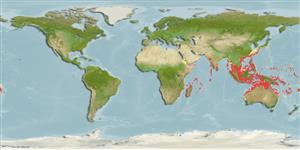Classification / Names
Common names | Synonyms | Catalog of Fishes (gen., sp.) | ITIS | CoL | WoRMS | Cloffa
Environment / Climate / Range
Ecology
Marine; demersal. Tropical, preferred ?
Distribution
Countries | FAO areas | Ecosystems | Occurrences | Point map | Introductions | Faunafri
Indo-West Pacific: Mauritius and India to Papua New Guinea; north to China; south to Australia,
Size / Weight / Age
Maturity: Lm ? range ? - ? cm
Max length : 13.9 cm SL male/unsexed; (Ref. 75583)
Short description
Morphology | Morphometrics
Dorsal
spines
(total): 8;
Dorsal
soft rays
(total): 16;
Anal
spines: 3;
Anal
soft rays: 14 - 15. This species belonging to the Leiognathus splendens complex is distinguished by the following characters: cheek no scales; anterior dorsolateral body surface almost entirely scaled with a semicircular naked area on nape; lower margin of inner preopercular ridge smooth; no scales on interspace of pelvic keels; second spines of dorsal and anal fins are weak (width of second spines of dorsal and anal fins 0.72-1.1% SL and 0.60-0.95% SL, respectively); a dark blotch on spinous dorsal fin rather pale, grayish (Ref. 75583).
Life cycle and mating behavior
Maturity | Reproduction | Spawning | Eggs | Fecundity | Larvae
Kimura, S., T. Ito, T. Peristiwady, Y. Iwatsuki, T. Yoshino and P.N. Dunlap, 2005. The Leiognathus splendens complex (Perciformes: Leignothidae) with the description of a new species, Leiognathus kupanensis kimura and Peristiwady. Ichthyol. Res. 52 (3):275-291. (Ref. 75583)
IUCN Red List Status (Ref. 115185)
CITES (Ref. 94142)
Not Evaluated
Threat to humans
Harmless
Human uses
More information
CountriesFAO areasEcosystemsOccurrencesIntroductionsStocksEcologyDietFood itemsFood consumptionRation
Common namesSynonymsMetabolismPredatorsEcotoxicologyReproductionMaturitySpawningFecundityEggsEgg development
Age/SizeGrowthLength-weightLength-lengthLength-frequenciesMorphometricsMorphologyLarvaeLarval dynamicsRecruitmentAbundance
ReferencesAquacultureAquaculture profileStrainsGeneticsAllele frequenciesHeritabilityDiseasesProcessingMass conversion
Tools
Special reports
Download XML
Internet sources
Estimates of some properties based on models
Phylogenetic diversity index (Ref.
82805): PD
50 = 0.5625 [Uniqueness, from 0.5 = low to 2.0 = high].
Bayesian length-weight: a=0.01905 (0.00853 - 0.04255), b=2.98 (2.80 - 3.16), in cm Total Length, based on LWR estimates for this (Sub)family-body shape (Ref.
93245).
Trophic Level (Ref.
69278): 3.0 ±0.4 se; Based on size and trophs of closest relatives
Resilience (Ref.
69278): High, minimum population doubling time less than 15 months (Preliminary K or Fecundity.).
Vulnerability (Ref.
59153): Low vulnerability (15 of 100) .
